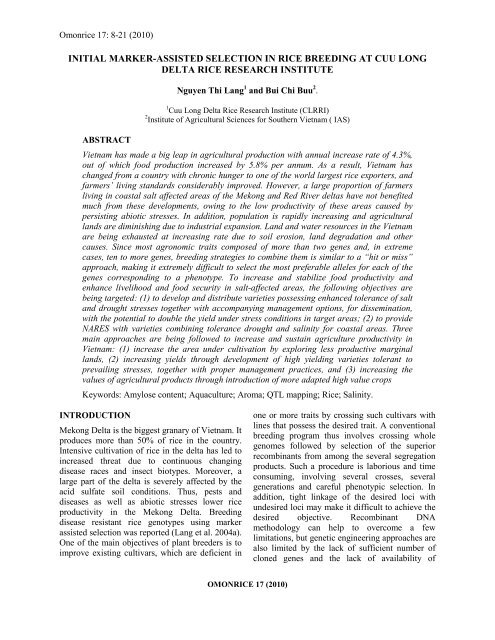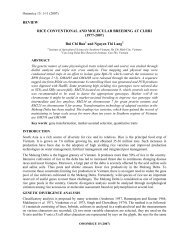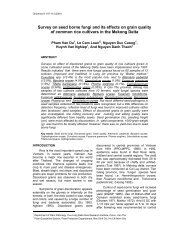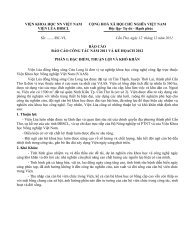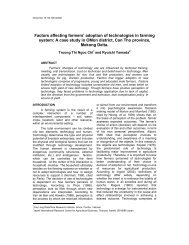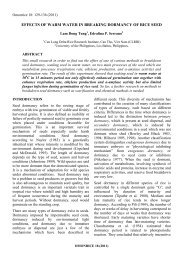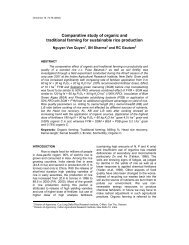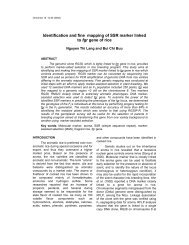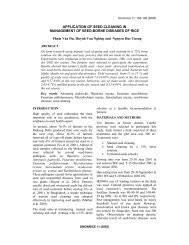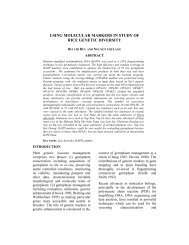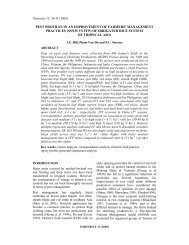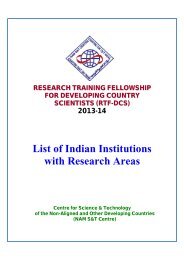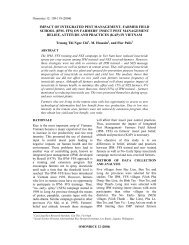initial marker-assisted selection in rice breeding at cuu long delta ...
initial marker-assisted selection in rice breeding at cuu long delta ...
initial marker-assisted selection in rice breeding at cuu long delta ...
Create successful ePaper yourself
Turn your PDF publications into a flip-book with our unique Google optimized e-Paper software.
Omon<strong>rice</strong> 17: 8-21 (2010)INITIAL MARKER-ASSISTED SELECTION IN RICE BREEDING AT CUU LONGDELTA RICE RESEARCH INSTITUTENguyen Thi Lang 1 and Bui Chi Buu 2 .1 Cuu Long Delta Rice Research Institute (CLRRI)2 Institute of Agricultural Sciences for Southern Vietnam ( IAS)ABSTRACTVietnam has made a big leap <strong>in</strong> agricultural production with annual <strong>in</strong>crease r<strong>at</strong>e of 4.3%,out of which food production <strong>in</strong>creased by 5.8% per annum. As a result, Vietnam haschanged from a country with chronic hunger to one of the world largest <strong>rice</strong> exporters, andfarmers’ liv<strong>in</strong>g standards considerably improved. However, a large proportion of farmersliv<strong>in</strong>g <strong>in</strong> coastal salt affected areas of the Mekong and Red River <strong>delta</strong>s have not benefitedmuch from these developments, ow<strong>in</strong>g to the low productivity of these areas caused bypersist<strong>in</strong>g abiotic stresses. In addition, popul<strong>at</strong>ion is rapidly <strong>in</strong>creas<strong>in</strong>g and agriculturallands are dim<strong>in</strong>ish<strong>in</strong>g due to <strong>in</strong>dustrial expansion. Land and w<strong>at</strong>er resources <strong>in</strong> the Vietnamare be<strong>in</strong>g exhausted <strong>at</strong> <strong>in</strong>creas<strong>in</strong>g r<strong>at</strong>e due to soil erosion, land degrad<strong>at</strong>ion and othercauses. S<strong>in</strong>ce most agronomic traits composed of more than two genes and, <strong>in</strong> extremecases, ten to more genes, breed<strong>in</strong>g str<strong>at</strong>egies to comb<strong>in</strong>e them is similar to a “hit or miss”approach, mak<strong>in</strong>g it extremely difficult to select the most preferable alleles for each of thegenes correspond<strong>in</strong>g to a phenotype. To <strong>in</strong>crease and stabilize food productivity andenhance livelihood and food security <strong>in</strong> salt-affected areas, the follow<strong>in</strong>g objectives arebe<strong>in</strong>g targeted: (1) to develop and distribute varieties possess<strong>in</strong>g enhanced tolerance of saltand drought stresses together with accompany<strong>in</strong>g management options, for dissem<strong>in</strong><strong>at</strong>ion,with the potential to double the yield under stress conditions <strong>in</strong> target areas; (2) to provideNARES with varieties comb<strong>in</strong><strong>in</strong>g tolerance drought and sal<strong>in</strong>ity for coastal areas. Threema<strong>in</strong> approaches are be<strong>in</strong>g followed to <strong>in</strong>crease and susta<strong>in</strong> agriculture productivity <strong>in</strong>Vietnam: (1) <strong>in</strong>crease the area under cultiv<strong>at</strong>ion by explor<strong>in</strong>g less productive marg<strong>in</strong>allands, (2) <strong>in</strong>creas<strong>in</strong>g yields through development of high yield<strong>in</strong>g varieties tolerant toprevail<strong>in</strong>g stresses, together with proper management practices, and (3) <strong>in</strong>creas<strong>in</strong>g thevalues of agricultural products through <strong>in</strong>troduction of more adapted high value cropsKeywords: Amylose content; Aquaculture; Aroma; QTL mapp<strong>in</strong>g; Rice; Sal<strong>in</strong>ity.INTRODUCTIONMekong Delta is the biggest granary of Vietnam. Itproduces more than 50% of <strong>rice</strong> <strong>in</strong> the country.Intensive cultiv<strong>at</strong>ion of <strong>rice</strong> <strong>in</strong> the <strong>delta</strong> has led to<strong>in</strong>creased thre<strong>at</strong> due to cont<strong>in</strong>uous chang<strong>in</strong>gdisease races and <strong>in</strong>sect biotypes. Moreover, alarge part of the <strong>delta</strong> is severely affected by theacid sulf<strong>at</strong>e soil conditions. Thus, pests anddiseases as well as abiotic stresses lower <strong>rice</strong>productivity <strong>in</strong> the Mekong Delta. Breed<strong>in</strong>gdisease resistant <strong>rice</strong> genotypes us<strong>in</strong>g <strong>marker</strong><strong>assisted</strong> <strong>selection</strong> was reported (Lang et al. 2004a).One of the ma<strong>in</strong> objectives of plant breeders is toimprove exist<strong>in</strong>g cultivars, which are deficient <strong>in</strong>one or more traits by cross<strong>in</strong>g such cultivars withl<strong>in</strong>es th<strong>at</strong> possess the desired trait. A conventionalbreed<strong>in</strong>g program thus <strong>in</strong>volves cross<strong>in</strong>g wholegenomes followed by <strong>selection</strong> of the superiorrecomb<strong>in</strong>ants from among the several segreg<strong>at</strong>ionproducts. Such a procedure is laborious and timeconsum<strong>in</strong>g, <strong>in</strong>volv<strong>in</strong>g several crosses, severalgener<strong>at</strong>ions and careful phenotypic <strong>selection</strong>. Inaddition, tight l<strong>in</strong>kage of the desired loci withundesired loci may make it difficult to achieve thedesired objective. Recomb<strong>in</strong>ant DNAmethodology can help to overcome a fewlimit<strong>at</strong>ions, but genetic eng<strong>in</strong>eer<strong>in</strong>g approaches arealso limited by the lack of sufficient number ofcloned genes and the lack of availability ofOMONRICE 17 (2010)
Initial <strong>marker</strong>-<strong>assisted</strong> <strong>selection</strong> <strong>in</strong> <strong>rice</strong> breed<strong>in</strong>g <strong>at</strong> Cuu Long <strong>delta</strong> <strong>rice</strong> research <strong>in</strong>stitute9standardized transform<strong>at</strong>ion protocols <strong>in</strong> manycrop species. Moreover, polygenic traits aredifficult to manipul<strong>at</strong>e by genetic eng<strong>in</strong>eer<strong>in</strong>gprocedures. With the advent of DNA <strong>marker</strong>technology, several types of DNA <strong>marker</strong>s arenow available to plant breeders and geneticists,help<strong>in</strong>g them to overcome many of the problemsfaced dur<strong>in</strong>g conventional breed<strong>in</strong>g. This paperreports on some of the applic<strong>at</strong>ions of DNA<strong>marker</strong> technology <strong>in</strong> our research, for geneticanalysis and characteriz<strong>at</strong>ion of various <strong>rice</strong>accessions, f<strong>in</strong>gerpr<strong>in</strong>t<strong>in</strong>g for purity tests, as wellas for use <strong>in</strong> <strong>marker</strong> <strong>assisted</strong> backcross<strong>in</strong>g(MASC) to breed <strong>rice</strong> varieties and hybridspossessiong particular traits such as specific gra<strong>in</strong>quality and tolerance to particular biotic andabiotic stresses.Segreg<strong>at</strong>ion analysis and germplasm/parentalsurveysThe most important step <strong>in</strong> segreg<strong>at</strong>ion analysis isthe <strong>selection</strong> of the appropri<strong>at</strong>e parental l<strong>in</strong>es. Theparents should be genetically divergent enough toexhibit sufficient polymorphism. The parents arecrossed to produce the segreg<strong>at</strong><strong>in</strong>g popul<strong>at</strong>ion,which could be an F2, backcross, recomb<strong>in</strong>ant<strong>in</strong>bred l<strong>in</strong>es (RILs), or double haploids (DH). Forexample polymorphism between parents isidentified us<strong>in</strong>g PCR-based <strong>marker</strong>s. We made 10crosses (Table1) to evalu<strong>at</strong>e the geneticbackgrounds and <strong>in</strong>trogression of new varietiesfrom donor varieties. The graphical genotypes ofthe popul<strong>at</strong>ion were constructed us<strong>in</strong>g RM13simple sequence repe<strong>at</strong> (SSR <strong>marker</strong>). Five allelicconditions of the plants susceptible to the diseasewere detected: homozygotes for tolerance allele,homozygotes for susceptible allele andheterozygotes.Table 1: Allelic condition of RM13 locus <strong>in</strong> F2 popul<strong>at</strong>ions (with bacterial leaf blight reaction)No. Design<strong>at</strong>ion Allele Size (bp)1 IR64 B 1502 IR64 x C53 A, B 300, 1503 IR64 x Jasm<strong>in</strong>e85 B, E 100-1504 IR64 x OM2514 A B5 IR24 B 1506 IR24 x IR64 B 1507 IR24 x IR36 B, C 120-1508 IR36 C 1209 IR36 x IR24 C, B 120-15010 IR36 x Jasm<strong>in</strong>e85 C 12011 IR36 x OM2514 C, D 120-14012 C53 A 30013 C53 x OM2514 A, D 300-14014 Jasm<strong>in</strong>e85 E 10015 Jasm<strong>in</strong>e85 x IR64 E, B 100-150Anther culture shortens the breed<strong>in</strong>g cycle byrapid gener<strong>at</strong>ion of homozygous l<strong>in</strong>es <strong>in</strong> a s<strong>in</strong>glegener<strong>at</strong>ion. Anther culture l<strong>in</strong>es from the crossesof C53/Doc Phung and C53/Pokkali, have beendeveloped and genotyped by RM223 (Table 2)OMONRICE 17 (2010)
10Nguyen Thi Lang et al.Table 2. Allelic vari<strong>at</strong>ion of RM 223 locus <strong>in</strong> anther culture-derived popul<strong>at</strong>ions (A2)S. No. Design<strong>at</strong>ion Allele Size (bp)1 IR28 A 1602 Pokkali B 1403 C53/Doc phụng-1 A 1604 C53/Doc phụng-2 A 1605 C53/Doc phụng-3 A 1606 C53/Doc phụng-17 B 1407 C53/Doc phụng-19 B 1408 C53/Pokkali-1 A 1609 C53/Pokkali-2 A 16010 C53/Pokkali-3 A 16011 C53/Pokkali-5 B 14012 C53/Pokkali-11 B 14013 C53/Pokkali-25 A 16014 C53/Pokkali-26 A 16015 C53/Pokkali-27 B 14016 C53/Pokkali-42 B 14017 C53/Pokkali-43 B 14018 C53/Pokkali-44 AB 140-160DNA <strong>marker</strong>s can also be used for f<strong>in</strong>gerpr<strong>in</strong>t<strong>in</strong>g,and this approach has recently been usedextensively for determ<strong>in</strong><strong>in</strong>g seed purity such as theexample of the genotypes, Ngang thom Cho Daoand Nang Nhen (Table 3).Table.3. Applic<strong>at</strong>ion of SSR <strong>marker</strong>s for f<strong>in</strong>gerpr<strong>in</strong>t<strong>in</strong>g of Nang Nhen variety detected a mixture of 30l<strong>in</strong>es.Marker Numbers of allele Chromosome PCR productRM13 3 5 23RM223 4 2 23RM106 3 8 28Inform<strong>at</strong>ion on the genetic diversity <strong>in</strong> a cropspecies is important for <strong>selection</strong> of parental l<strong>in</strong>es,for construction of popul<strong>at</strong>ions, for variouspurposes and also for study<strong>in</strong>g genetic variabilitywith<strong>in</strong> a species. for example from wild <strong>rice</strong> O.offic<strong>in</strong>alis is shown <strong>in</strong> Fig. 1130bp 140bp 150bp 120bp 110bpFigure 1. PCR – based DNA characteriz<strong>at</strong>ion of some Oryza offic<strong>in</strong>alis popul<strong>at</strong>ions <strong>at</strong> locus RM270.OMONRICE 17 (2010)
Initial <strong>marker</strong>-<strong>assisted</strong> <strong>selection</strong> <strong>in</strong> <strong>rice</strong> breed<strong>in</strong>g <strong>at</strong> Cuu Long <strong>delta</strong> <strong>rice</strong> research <strong>in</strong>stitute11Table 4. Genotyp<strong>in</strong>g of selected l<strong>in</strong>es of O. offic<strong>in</strong>alis us<strong>in</strong>g <strong>marker</strong> RM270.No. Design<strong>at</strong>ion Accession Allele Size (bp)M Marker1 O. offic<strong>in</strong>alis C 130 bp2 O. offic<strong>in</strong>alis C 130 bp3 O. offic<strong>in</strong>alis 1934 O. offic<strong>in</strong>alis 195 C 130 bp5 O. offic<strong>in</strong>alis 196 B 140 bp6 O. offic<strong>in</strong>alis 216 C 130 bp7 O. offic<strong>in</strong>alis 236 B 140 bp8 O. offic<strong>in</strong>alis 235 B 140 bp9 O. offic<strong>in</strong>alis 231 B 140 bp10 O. offic<strong>in</strong>alis 234 C 130 bp11 O. offic<strong>in</strong>alis 230 A 150 bp12 O. offic<strong>in</strong>alis 233 C 130 bp13 O. offic<strong>in</strong>alis 22914 O. offic<strong>in</strong>alis 232 D 120 bp15 O. offic<strong>in</strong>alis 228 E 110 bp16 PTB33 A 150 bpUnderstand<strong>in</strong>g germplasm rel<strong>at</strong>ionshipsUnderstand<strong>in</strong>g and management of the n<strong>at</strong>uralvari<strong>at</strong>ion present with<strong>in</strong> the domestic cultivars andwild rel<strong>at</strong>ives of a plant species is very important<strong>in</strong> the establishment of an efficient program aimed<strong>at</strong> crop improvement. Exploit<strong>in</strong>g n<strong>at</strong>ural vari<strong>at</strong>ionis very important for several reasons: geneticuniformity <strong>in</strong> crops is undesirable because it tendsto make the crop vulnerable to epidemics andenvironmental disasters result<strong>in</strong>g <strong>in</strong> yield loss.Many wild rel<strong>at</strong>ives of crop plants conta<strong>in</strong> geneswhich confer resistance to biotic stresses such aspests and diseases and tolerance to abiotic stressessuch as drought, cold, and sal<strong>in</strong>ity (Lang et al,2005a). When such traits are <strong>in</strong>corpor<strong>at</strong>ed <strong>in</strong>toeconomically important varieties, large yieldlosses can be avoided. In addition, the breeder alsoaims <strong>at</strong> improv<strong>in</strong>g certa<strong>in</strong> desired characters suchas gra<strong>in</strong> quality and yield for specific end uses. Apre-requisite for improv<strong>in</strong>g the overall plantcharacteristics is an understand<strong>in</strong>g of the structureof the germplasm collection, which <strong>in</strong> turn willallow a system<strong>at</strong>ic sampl<strong>in</strong>g of the germplasm forbreed<strong>in</strong>g and conserv<strong>at</strong>ion purposes.The genetic diversity and varietal identities of 100local varieties with bacterial leaf blight resistancewas studied. This genetic divesity ranged from0.24 to 0.60 with an average of 0.40. DNA<strong>marker</strong>s have been used to quantify the geneticdiversity and determ<strong>in</strong>e phenetic rel<strong>at</strong>ionships <strong>in</strong>several <strong>rice</strong> species. Cluster analysis was usefulfor study<strong>in</strong>g the rel<strong>at</strong>ionships among closelyrel<strong>at</strong>ed accessions. The diversity of the 100traditional varieties from Mekong <strong>delta</strong> wasassessed us<strong>in</strong>g 34 polymorphic SSR <strong>marker</strong>s andquantit<strong>at</strong>ive morphological characters. Moleculardiversity analysis revealed genetic diversity amongthe 100 traditional varieties, which gener<strong>at</strong>ed fiveclusters <strong>at</strong> 0.72 similarity coefficient. Some withthe same variety names were classified <strong>in</strong>todifferent clusters. Though they be<strong>long</strong> to the samecluster based on morphological <strong>marker</strong>s,molecular analysis showed th<strong>at</strong> they weregenetically different. The genetic diversity valueranged from 0.116 to 0.894 with an average of0.724 (Table 5)OMONRICE 17 (2010)
12Nguyen Thi Lang et al.Table 5. Genetic divesity value of 100 local accessions us<strong>in</strong>g 34 polymorphic SSR <strong>marker</strong>s.Cluster HI 0.1667II 0..1171III 0.6055IV 0.3633V 0.8947Average 0.7242Both the morphological and the SSR <strong>marker</strong>s wereable to classify the <strong>rice</strong> varieties <strong>in</strong>to these agroecologicalgroups, while (pr<strong>in</strong>cipal componentanalysis) provides a more complete represent<strong>at</strong>ionof the rel<strong>at</strong>ionships among major groups. In a“core” collection, the <strong>in</strong>dividuals, varieties, oraccessions are classified <strong>in</strong>to a limited number ofentities based on their degree of similarity and alimited number of genotypes can efficientlyrepresent a much larger group. A “core” collectionthus represents most of the diversity <strong>in</strong> thegermplasm collection and allows one toextrapol<strong>at</strong>e conclusions to the entire collection.DNA f<strong>in</strong>gerpr<strong>in</strong>t<strong>in</strong>g has been found to extensiveapplic<strong>at</strong>ions <strong>in</strong> assessment of seed purity,resolution of uncerta<strong>in</strong>ties, parentage, legalprotection of improved varieties and geneticdiagnostics.Construction of genetic l<strong>in</strong>kage mapsDNA <strong>marker</strong>s <strong>in</strong> plants have been used for thedevelopment of detailed l<strong>in</strong>kage maps. In order toefficiently use the <strong>in</strong>numerable polymorphisms asgenetic <strong>marker</strong>s, knowledge of their <strong>in</strong>dividualgenomic loc<strong>at</strong>ions is necessary and this<strong>in</strong>form<strong>at</strong>ion can be obta<strong>in</strong>ed by construct<strong>in</strong>g agenetic l<strong>in</strong>kage map. Thus, a genetic l<strong>in</strong>kage mapgraphically represents the arrangement of the<strong>in</strong>numerable loci, which <strong>in</strong>clude morphologicaltraits, isozymes, as well as DNA <strong>marker</strong>s, a<strong>long</strong>the chromosome. The distance between these lociis expressed <strong>in</strong> centimorgan (cM) which representsthe recomb<strong>in</strong><strong>at</strong>ion r<strong>at</strong>es between the loci (1 cM=10% recomb<strong>in</strong><strong>at</strong>ion). Examples of genetic l<strong>in</strong>kagemaps constructed <strong>in</strong> <strong>rice</strong> <strong>at</strong> the CLRRI formapp<strong>in</strong>g specific traits are shown <strong>in</strong> Table 6.Table 6. Construction of genetic l<strong>in</strong>kage some maijor genes <strong>in</strong> <strong>rice</strong> <strong>at</strong> CLRRITarget Trait Chromosomeloc<strong>at</strong>ion ofQTLs1 QTL forsalt stressL<strong>in</strong>ked <strong>marker</strong>s Popul<strong>at</strong>ion Reference12 C560-C747 ,R3156- C563,C1454 , C397,R1684Tenasai 2 / CBLang et al . 2001a2 Salt Tol 8 RM223 IR28/ Doc Phụng Lang et al. 2001b3 Salt Tol 1 RM315 IR64/OMCSBuu.and.Lang.2000//OMCS2000; 2004aIR64/OM 1706//Om17064 Salt Tol 2 OSR1 IR64/OM 1706//Om 1706 Buu and Lang2004b5 P12 OM 2395/ AS 996 Lang et al , 2005deficiencytolerance6 Droughttolerance9 RM201 l<strong>in</strong>kage 0,4cMOM 1490/WAB880-1-38-18-20-P1-HBLang et al., 2007OMONRICE 17 (2010)
Initial <strong>marker</strong>-<strong>assisted</strong> <strong>selection</strong> <strong>in</strong> <strong>rice</strong> breed<strong>in</strong>g <strong>at</strong> Cuu Long <strong>delta</strong> <strong>rice</strong> research <strong>in</strong>stitute13Target Trait Chromosomeloc<strong>at</strong>ion ofQTLs7 BrownplanthopperLang et al.,19998 Brownplanthopper ResL<strong>in</strong>ked <strong>marker</strong>s Popul<strong>at</strong>ion Reference12 RM457F-R ,l<strong>in</strong>kage <strong>at</strong> 3.5 cM12 RM270 , l<strong>in</strong>kage0.2 cM RM260, 5cMPTB33 / TN1IR64/ Hoa LaiLang et al., 2005b9 Aroma 8 RM223, RG28F-R IR64/ Hoa Lai Lang et al 2004c10 Amylose 6 RM42, RM276 IR 64/ KhaoDawMali 105 Lang et al 2004dContent11 Blast R 6 RG64:1,0cM OM 1308 / Te tep Lang et al., 20033,8 cM - 4,8 and Soc Nau / OM99712 Gra<strong>in</strong>Prote<strong>in</strong>7 RM234 BC 2 F 2 IR64 / Khao DawkMali 105 .Lang et al., 2005bMarker Assited Selection (MAS) for major genesMAS is based on the concept th<strong>at</strong> it is possible to<strong>in</strong>fer the presence of a gene from the presence of a<strong>marker</strong> th<strong>at</strong> is tightly l<strong>in</strong>ked to the gene. If the<strong>marker</strong> and the gene are loc<strong>at</strong>ed far apart then thepossibility, they will be transmitted together to theprogeny <strong>in</strong>dividuals. They will be reduced due todouble crossover recomb<strong>in</strong><strong>at</strong>ion events. Hence, aprerequisite to us<strong>in</strong>g <strong>marker</strong>s <strong>in</strong> such <strong>selection</strong> isth<strong>at</strong> they should be tightly l<strong>in</strong>ked to the gene of<strong>in</strong>terest. For this purpose, s<strong>at</strong>ur<strong>at</strong>ion of specificregions conta<strong>in</strong><strong>in</strong>g the gene of <strong>in</strong>terest on thegenetic l<strong>in</strong>kage map is necessary.Gra<strong>in</strong> qualityThis study was undertaken with the view to taggene(s) controll<strong>in</strong>g gra<strong>in</strong> prote<strong>in</strong> content (GPC)us<strong>in</strong>g molecular <strong>marker</strong>s <strong>in</strong> <strong>rice</strong>. Genotype IR64with low prote<strong>in</strong> content (7.5%) was crossed togenotype Nang thom Cho Dao with high prote<strong>in</strong>content (10.62%) and BC3F2 popul<strong>at</strong>ion of 149l<strong>in</strong>es was derived. The parental genotypes andBC3F2 popul<strong>at</strong>ion were analyzed with RM234.One primer pair for the locus RM234 showedassoci<strong>at</strong>ion with prote<strong>in</strong> content. This was furtherconfirmed through selective genotyp<strong>in</strong>g. The cosegreg<strong>at</strong>iond<strong>at</strong>a on the molecular <strong>marker</strong> andprote<strong>in</strong> content on 149 BC3F2 l<strong>in</strong>es was analysedus<strong>in</strong>g s<strong>in</strong>gle <strong>marker</strong> l<strong>in</strong>ear regression approach.The results showed th<strong>at</strong> the l<strong>in</strong>ked QTL accountedfor 18.1% of the vari<strong>at</strong>ion for prote<strong>in</strong> contentbetween the parents. Significant regressionsuggested l<strong>in</strong>kage between RM234 and a QTL forprote<strong>in</strong> content on chromosome 7. The resultsshowed th<strong>at</strong> this <strong>marker</strong>-l<strong>in</strong>ked QTL accounted for8.73% of the vari<strong>at</strong>ion for prote<strong>in</strong> content betweenthe parents. The <strong>marker</strong> has been loc<strong>at</strong>ed onchromosome arm 7 (Lang et al., 2005b)Amylose content is one of the importantcharacteristics of gra<strong>in</strong> quality of <strong>rice</strong> verities. Apolymorphic micros<strong>at</strong>ellite sequence closelyl<strong>in</strong>ked to the Wx gene was reported. .The genotypeHoa lai and Khao Daw Mali 105 with low amylosecontent (16.8% and 19.2%, respectively) werecrossed with IR64, with medium amylose content(24.5%), and 120 BC2F2 l<strong>in</strong>es were derived.These BC popul<strong>at</strong>ions showed normal distributionfor amylose content. One locus associ<strong>at</strong>ed withamylose content was identified near the Wx gene<strong>in</strong> both popul<strong>at</strong>ions (P < 0.000, R2= 17.8%, for IR64/ Hoa Lai and; and P < 0.0000 , R2 = 19.7% forIR64/KhawdawMali 105). The parental genotypeswere analysis with 20 primer pairs for SSR<strong>marker</strong>s on Chromosome 6. This QTL might beuseful <strong>in</strong> <strong>marker</strong>- <strong>assisted</strong> breed<strong>in</strong>g for theimprovement of <strong>rice</strong> amylose content.We also conducted genetic analysis of two traits:amylose content (AC) and gel consistency (GC),as the most important traits for cook<strong>in</strong>g and e<strong>at</strong><strong>in</strong>gOMONRICE 17 (2010)
14quality of <strong>rice</strong> gra<strong>in</strong>s. The m<strong>at</strong>erial used <strong>in</strong> theanalysis <strong>in</strong>cluded five groups: A0 (dur<strong>at</strong>ion from90-95 days) , A1 (dur<strong>at</strong>ion from 95-100 days), A2( dur<strong>at</strong>ion from 105-110-days), abiotic stresstolerant, and genotypes with specific traits such asaroma, together with IR64 ,Khao Daw Mali 105 aschecks A micros<strong>at</strong>ellite repe<strong>at</strong> th<strong>at</strong> is part of thedetected with gene amylose with <strong>marker</strong> RG42and GC for RM276. Three new varieties with lowamylose content such as: OM4900, Hau Giang 2,OM3536 . The higher significantly betweenphenotype and genotype of two traits .The aroma or good flavor of cooked <strong>rice</strong> has beenshown to be caused ma<strong>in</strong>ly by formaldehydes. Thegenomic clone RG28, which is tighly l<strong>in</strong>ked to frggene <strong>in</strong> <strong>rice</strong>, provides opportunities to perform<strong>marker</strong> aided <strong>selection</strong> <strong>in</strong> <strong>rice</strong> breed<strong>in</strong>g program.This study was conducted to identify the targetgene us<strong>in</strong>g SSR <strong>marker</strong>s (RM223 ) and STS (RG28FL-RB ) <strong>marker</strong>s l<strong>in</strong>ked to fgr gene <strong>in</strong> <strong>rice</strong>.RG28 can be converted by sequenc<strong>in</strong>g <strong>in</strong>to STSand used as <strong>marker</strong> for PCR amplific<strong>at</strong>ion ofgenomic DNA from <strong>rice</strong> varities differ<strong>in</strong>g <strong>in</strong> theiraroma . Genotypes of 16 local varieties and 49improved varieties were determ<strong>in</strong>ed by perform<strong>in</strong>gprogeny test<strong>in</strong>g for fgr. The results <strong>in</strong>dic<strong>at</strong>ed anaccuracy of close to 100% <strong>in</strong> identify<strong>in</strong>g arom<strong>at</strong>ic<strong>rice</strong> plants, which were similar to th<strong>at</strong> us<strong>in</strong>gRG28FL-RB. Germplasm survey was conductedfor parents <strong>selection</strong> for use <strong>in</strong> breed<strong>in</strong>g (Lang etal. 2006) .Phytic acid, myo-isositol 1, 2, 3, 4, 5, 6 –hexakisphosph<strong>at</strong>e (IP 6) is a major storagecompound of phosphorous (P) <strong>in</strong> plants. Rice gra<strong>in</strong>conta<strong>in</strong>s anti-nutritional factors, which reduce thebioavailability of iron and z<strong>in</strong>c. Phyt<strong>at</strong>e has beenknown to lower the absorption of these c<strong>at</strong>ions andother m<strong>in</strong>erals <strong>in</strong> humans and non-rum<strong>in</strong>antanimals. Induced mut<strong>at</strong>ions <strong>in</strong> the most importantcereals have been utilized to reduce the phyt<strong>at</strong>econtent of <strong>rice</strong> gra<strong>in</strong>s. All efforts to developmutants with low phytic acid content have beenrecognized <strong>in</strong> the development of four <strong>rice</strong>genotypes from different wild types asOMCS2000 and OM1490. Their <strong>rice</strong> gra<strong>in</strong>s weretre<strong>at</strong>ed with gamma radi<strong>at</strong>ion (20 kr) then screenedfor high levels of free phosph<strong>at</strong>e <strong>in</strong> order toidentify low phytic acid (LPA) mutants. The LPAphenotype was analyzed <strong>in</strong> mutants, wild types,Nguyen Thi Lang et al.101 improved varieties and 600 landraces. LPAmutants derived from OM1490, OMCS2000 <strong>in</strong>M3, M4 and M5 showed uniform agronomic traits(Lang et al. 2007)The advent of <strong>marker</strong> <strong>assisted</strong> <strong>selection</strong> permitsrapid identific<strong>at</strong>ion of <strong>in</strong>dividuals th<strong>at</strong> conta<strong>in</strong>genes for low phytic acid. The presence or absenceof the associ<strong>at</strong>ed molecular <strong>marker</strong> <strong>in</strong>dic<strong>at</strong>es, <strong>at</strong> anearly stage, the presence or absence of the desiredtarget gene. Segreg<strong>at</strong><strong>in</strong>g popul<strong>at</strong>ions were used toconfirm co-segreg<strong>at</strong>ion between SSR <strong>marker</strong>s andthe gene for LPA. Polymorphic <strong>marker</strong> RM207detected LPA <strong>in</strong> OM1490 mutants. Lane 1 (IR64)exhibited band of 200 bp and lane 2 showed Lpa-1<strong>at</strong> 220 bp. Lane 3-7 presented high phytic acidallele from the wild type OM1490, lane 8-12<strong>in</strong>dic<strong>at</strong>ed LPA of landraces as Nep than, Nep Hạtto, Nep Ao vang , Nep Thom and Nep Mau Luon.Our f<strong>in</strong>d<strong>in</strong>gs may help <strong>rice</strong> breeders to developlow phytic acid genotypes with improvednutritional value to overcome anemia syndromeand meet the demand of biofortific<strong>at</strong>ionBiotic stressBacterial Blight:Bacterial leaf blight (BB) caused by Xanthomonasoryzae pv. oryzae (Xoo) is one of the majordiseases of <strong>rice</strong> <strong>in</strong> the world. In some areas ofAsia, it can reduce crop yield by 50% (Khush etal., 1989) or even up to 80% (S<strong>in</strong>gh et al.1977 ).The disease caused by bacteria, also br<strong>in</strong>gs aboutreduction <strong>in</strong> the <strong>rice</strong> production. Plants genesgovern<strong>in</strong>g highly effective resistance to microbial<strong>at</strong>tack has been identified before, and often, theseresistance genes are clustered <strong>in</strong> specific region ofthe plant genome (Richter et al., 1995). Theseresistance genes be<strong>long</strong> to multigene families, andare closely l<strong>in</strong>ked. Resistance to bacterial blightwas transferred from wild species O.<strong>long</strong>istam<strong>in</strong><strong>at</strong>a to the cultiv<strong>at</strong>ed <strong>rice</strong> variety IR24gener<strong>at</strong><strong>in</strong>g the <strong>in</strong>trogression l<strong>in</strong>e IR-BB21 and thelocus Xa-21 was found to confer resistance to allknown Xanthomonas oryzae pv. oryzae <strong>in</strong> Indiaand the Philipp<strong>in</strong>es (Khush et al., 1990). Abouthundred and sixty six local accessions, and 25parental l<strong>in</strong>es of hybrid <strong>rice</strong> were screened for leafblight resistance us<strong>in</strong>g 10 <strong>in</strong>tern<strong>at</strong>ional bacterialraces <strong>in</strong> comparison with check varieties. Fivelocal cultivars were identified as resistant of theOMONRICE 17 (2010)
Initial <strong>marker</strong>-<strong>assisted</strong> <strong>selection</strong> <strong>in</strong> <strong>rice</strong> breed<strong>in</strong>g <strong>at</strong> Cuu Long <strong>delta</strong> <strong>rice</strong> research <strong>in</strong>stitute15bacterial races as IRBB21, 3 cultivars showedresistant reaction as IRBB5 and 58 cultivars wereresistant to the race No 4 and No 6 as IRBB13.These cultivars were subsequence genotyped us<strong>in</strong>gRG556, RG136 and PTA248 for detect<strong>in</strong>g xa-5,xa-13 and Xa-21 genes. PCR reactions us<strong>in</strong>gRG556 and PTA248 failed to detect xa-5 and Xa-21. Marker RG136 was successful <strong>in</strong> select<strong>in</strong>g 5local <strong>rice</strong> accessions and 3 parental l<strong>in</strong>es of hybrid<strong>rice</strong> conta<strong>in</strong><strong>in</strong>g xa-13 gene. A susceptible moderncultivar (IR24) and the resistant local genotype(Nang Som) were used for develop<strong>in</strong>g a backcrosspopul<strong>at</strong>ion to transfer recessive xa-13 gene.Bacterial blight resistance gene, xa-13, was notdetected <strong>in</strong> the first BC gener<strong>at</strong>ion. Screen<strong>in</strong>g of130 plants with IR24 phenotype <strong>in</strong> BC1F2popul<strong>at</strong>ion identified 20 plants th<strong>at</strong> were resistantto <strong>at</strong> least 6 races <strong>in</strong>clud<strong>in</strong>g race 4 and race 6(typical resistance phenotype of xa-13 gene).These plants were genotyped with 5 micros<strong>at</strong>ellite<strong>marker</strong>s (RM21, RM114, RM122, RM164, andRM190), of which 2 <strong>marker</strong>s RM21 and RM190,showed polymorphisim with the accuracy of 55%and 50%, respectively. In comparison with BBp<strong>at</strong>hogen reaction, these plants do not have xa-13gene but their resistance was caused by multiplegenes <strong>at</strong> other loci.Marker-<strong>assisted</strong> backcross<strong>in</strong>g (MABC) has beensuccessfully used by Huang et al. (1997) forpyramid<strong>in</strong>g four resistance genes <strong>in</strong>to IR24background. DNA <strong>marker</strong>-<strong>assisted</strong> <strong>selection</strong> wasemployed to select xa-13 and xa-5 bacterial blightresistance genes. Genotypes with both genes wereselected from NIL popul<strong>at</strong>ions <strong>in</strong>volv<strong>in</strong>g <strong>in</strong>dica x<strong>in</strong>dica crosses. DNA <strong>marker</strong>-<strong>assisted</strong> <strong>selection</strong> wasemployed to select xa-13, xa-5 and Xa-4 bacterialblight resistance genes. Genotypes with both geneswere selected from four BC4F4 popul<strong>at</strong>ions fromIR24/ Base (local Vietnamese variety). With theassistance of PCR-based <strong>marker</strong>s, 60 true breed<strong>in</strong>gl<strong>in</strong>es were identified from CLRRI and 100 BC4F4popul<strong>at</strong>ions were also subjected to <strong>marker</strong> <strong>assisted</strong><strong>selection</strong> for xa-13 locus. Plants were analyzedwith the STS <strong>marker</strong> RG136, which showedpolymorphism between IR24 and other parentall<strong>in</strong>es <strong>in</strong>volved <strong>in</strong> the crosses. PCR analysis wasconducted us<strong>in</strong>g oligos RG136 <strong>in</strong> an BC4F4popul<strong>at</strong>ion segreg<strong>at</strong><strong>in</strong>g for xa-13 locus.OMCS2000 showed band<strong>in</strong>g p<strong>at</strong>tern identical toth<strong>at</strong> of its xa-13 parent, Based on this, these plantswere therefore, assumed to carry xa-13 gene <strong>in</strong>homozygous st<strong>at</strong>e. The homozygotes andheterozygotes were scored and goodness of fit wastested. One hundred plants were raised from eachselected BC4F4 plant. Sixty (60) l<strong>in</strong>es raised fromeach selected l<strong>in</strong>e were tested aga<strong>in</strong>st 11 races ofbacterial blight p<strong>at</strong>hogen, and all the plantsshowed resistance to BB p<strong>at</strong>hogen. The resistancereaction was also confirmed us<strong>in</strong>g SSR and STS<strong>marker</strong>s for xa-13, xa-5 and Xa-4 resistance genes,and superior plants carry<strong>in</strong>g Xa-5 gene wereselected (OM 2517 and OM 5636). Besides, fivel<strong>in</strong>es carry<strong>in</strong>g Xa-4 gene (OM 2718, AS996,OM2514 , OMCS2000 and DS2002) wereselected. In total, 60 phenotypically superior plantscarry<strong>in</strong>g genes for resistance were selected (Phucand Lang, 2005).Blast resistanceBlast is caused by Pyricularia grisea Cav., is oneof the major fungal diseases of <strong>rice</strong> <strong>in</strong> Vietnam.Local varieties have been considered as geneticsources of disease resistance. This study aims <strong>at</strong>us<strong>in</strong>g DNA <strong>marker</strong> <strong>assisted</strong> <strong>selection</strong> to breedvarieties th<strong>at</strong> have blast resistance genes such asPi-2(t), Pi-5(t) and Pi-3(t). STS <strong>marker</strong> RG64 wasused to screen 100 local varieties for the presenceof Pi-2(t) <strong>in</strong> chromosome 6, and SSR <strong>marker</strong>RM21 was used for Pi-5(t) and Pi-3(t) genes <strong>in</strong>chromosome 4. Phenotypic evalu<strong>at</strong>ion was used tocompare selected l<strong>in</strong>es with checks to evalu<strong>at</strong>e theaccuracy of genotypic <strong>selection</strong> us<strong>in</strong>g these<strong>marker</strong>s, and the d<strong>at</strong>a showed th<strong>at</strong> MAS has anaccuracy of 100% for the STS <strong>marker</strong> RG64 and99.49% for SSR <strong>marker</strong> RM21. These <strong>marker</strong>s,are therefore sufficiently accur<strong>at</strong>e for use <strong>in</strong>breed<strong>in</strong>g to select breed<strong>in</strong>g l<strong>in</strong>es th<strong>at</strong> have blastresistance genes. The local genotypes NangHuong, Lem Bui, Soi Da, Nang Tra, Nang Tra RanDoc, Soc Nau, and Te Tep have 3 blast resistancegenes Pi-2(t), Pi-5(t), and Pi-3(t), and areconsidered as valuable m<strong>at</strong>erial for pyramid<strong>in</strong>gresistance genes to develop varieties with durableresistance.Development of blast resistant <strong>rice</strong> varietiesThe resistance genes <strong>in</strong> CLRRI <strong>rice</strong> varieties wereexam<strong>in</strong>ed based on reaction p<strong>at</strong>terns of isol<strong>at</strong>es ofblast Pyricularia grisea Sacc., from CLRRI. ToOMONRICE 17 (2010)
16confirm the genes, genetic analyses were carriedout us<strong>in</strong>g BC1F2 progenies derived from crossesof IRRI varieties with IR24 and IR36 . This studydemonstr<strong>at</strong>ed the utility of differential system <strong>in</strong>elucid<strong>at</strong><strong>in</strong>g the genetic constitution of CLRRI andIRRI varieties for blast resistance (Table 8). Abackcross popul<strong>at</strong>ion consist<strong>in</strong>g of 118 BC2F2l<strong>in</strong>es derived from IR24 / OM2514 was analysedfor blast resistance genes and genotyped with 14simple sequence repe<strong>at</strong> (SSR) <strong>marker</strong>s. One SSR<strong>marker</strong> (RM21) was significantly associ<strong>at</strong>ed withNguyen Thi Lang et al.blast resistance <strong>in</strong> <strong>rice</strong> (P=0.01). These <strong>marker</strong>saccounted for phenotypic vari<strong>at</strong>ion rang<strong>in</strong>g from9.6% to 20.5% and contributed to 66% of the totalvari<strong>at</strong>ion of percentage diseased leaf area (DLA)observed under n<strong>at</strong>ural <strong>in</strong>fection. To evalu<strong>at</strong>e thegenetic backgrounds and <strong>in</strong>trogression ofresistance genes from donor varieties, thegraphical genotypes of the popul<strong>at</strong>ion wereconstructed us<strong>in</strong>g 3 SSR <strong>marker</strong>s, RM44, RM111,RM483 and <strong>marker</strong> φX174 – HaeIII (Fig 2). Thesem<strong>at</strong>erials will further be used for breed<strong>in</strong>g.Table 7. Reaction p<strong>at</strong>tern of F2 l<strong>in</strong>es from IR24/OM2514 and IR36/OM2514 to blast isol<strong>at</strong>es fromCLRRI (OMP -1)Design<strong>at</strong>ion Scorereaction 0Scorereaction 1Scorereaction 3Scorereaction 5Scorereaction 7Scorereaction 9IR24 30OM2514 30F1 50 32 27 44 27 75BC1F2 32 45 22 44 27 75IR36 / OM2514IR36 10OM2514 30F1 50BC1F2 12 40 34 27 50 25A set of 28 differential varieties is a useful tool toidentify blast resistance genes <strong>in</strong> <strong>rice</strong> and tocharacterize the new varieties. The reactions of 28l<strong>in</strong>es to the blast isol<strong>at</strong>es from CLRRI wereconfirmed us<strong>in</strong>g <strong>marker</strong>s RM44, RM111, RM483together with <strong>marker</strong> φX174 – Hae III .Introgression of a resistance gene for brown planthopper ( BPH)Several wild species of <strong>rice</strong> with high degree ofresistance to pests have been identified <strong>at</strong> IRRI.Similarly, O. rufipogon, a wild <strong>rice</strong> is tolerant toacid sulf<strong>at</strong>e soils th<strong>at</strong> occurs <strong>in</strong> Dong thap Muoi,Vietnam. The wild species thus offer gre<strong>at</strong>potential to transfer genes for tolerance to bioticand abiotic stresses <strong>in</strong>to <strong>rice</strong> cultivars. CLRRI hasgener<strong>at</strong>ed a series of hybrids, and <strong>in</strong>trogressionl<strong>in</strong>es from the crosses of elite breed<strong>in</strong>g l<strong>in</strong>es of <strong>rice</strong>with several wild species. Genes for resistance tobrown plant hopper (BPH), bacterial leaf blightand blast have been transferred from several wildrel<strong>at</strong>ives <strong>in</strong>to cultiv<strong>at</strong>ed <strong>rice</strong>. The BPH resistantl<strong>in</strong>e from O. s<strong>at</strong>iva / O. offic<strong>in</strong>alis have beenreleased as commercial variety for cultiv<strong>at</strong>ion <strong>in</strong>Mekong Delta such as AS 996. Some of the genes<strong>in</strong>trogressed from wild species have been taggedwith molecular <strong>marker</strong>s. IRRI and CLRRI havestrong on-go<strong>in</strong>g collabor<strong>at</strong>ion on the evalu<strong>at</strong>ionand utiliz<strong>at</strong>ion of wide cross progenies. Under theRockefeller Found<strong>at</strong>ion (RF) support, tagg<strong>in</strong>g ofBPH resistance loci was conducted withmicros<strong>at</strong>ellite <strong>marker</strong>s <strong>at</strong> Texas A&M Universityfrom Oryza offic<strong>in</strong>alis / IR50 (Buu et al., 2005). Itshowed th<strong>at</strong> the genes for BPH resistance (biotype4) are l<strong>in</strong>ked with RM18 on chromosome 7 <strong>at</strong> adistance of 1.3 cM, and RM168 on chromosome 3<strong>at</strong> a distance of 1.9 cM.Backcross progenies from crosses with IR64 / O.rufipogon and IR64 / O. offic<strong>in</strong>alis were evalu<strong>at</strong>edfor BPH resistance. The results <strong>in</strong>dic<strong>at</strong>ed th<strong>at</strong> O.offic<strong>in</strong>alis was a good donor resistant to BPH(Table 8)OMONRICE 17 (2010)
Initial <strong>marker</strong>-<strong>assisted</strong> <strong>selection</strong> <strong>in</strong> <strong>rice</strong> breed<strong>in</strong>g <strong>at</strong> Cuu Long <strong>delta</strong> <strong>rice</strong> research <strong>in</strong>stitute17Table 8. Reaction p<strong>at</strong>terns of BC2F1 l<strong>in</strong>es to BPH from VietnamNumbers Design<strong>at</strong>ion Numbers ofsuceptibleplantsBph RGSV RRSV ??Numbers Numbers of Numbers R f Numbers forof resistant suceptible (medium) Plants R resistance)plants plants1 IR64/ O.Rufipogon 56 170 26 226 0 2262 IR 64/Nang ThomCho Dao 356 12 15 353 10 3583 IR 64/ O.offic<strong>in</strong>alis 30 91 0 121 0 121R: resistanceBrown plant hopper causes direct damage bysuck<strong>in</strong>g plant sap, and it also tranmits several viraldiseases such as <strong>rice</strong> grassy stunt (RGSV; Riveraet al 1966) and ragged stunt (RRSV; L<strong>in</strong>g et al.,1978). About 121 l<strong>in</strong>es derived from the crossIR64 / O. offic<strong>in</strong>alis were evalu<strong>at</strong>ed. It <strong>in</strong>dic<strong>at</strong>edth<strong>at</strong> all l<strong>in</strong>es were resistant to RGSV and RRSVwhile l<strong>in</strong>es derived from IR64 / Nang Thom ChoDao and IR64 /O. rufipogon were less resistant.The survey revealed three <strong>marker</strong>s RM270 l<strong>in</strong>kedto target regions on chromosome 12 th<strong>at</strong> conta<strong>in</strong>edgenes for BPH resistance. O. offic<strong>in</strong>alis had largeeffects on BPH resistance. The five loci<strong>in</strong>dependently acted of each other <strong>in</strong> determ<strong>in</strong><strong>in</strong>gthe resistance. However, the record did not detectpolymorphism for Oryza rufipogon.Abiotic stressEnvironmental stresses such as drought, sal<strong>in</strong>ity,submergence, and phosphorus deficiency aremajor factors limit<strong>in</strong>g plant productivity. Plantshave developed different physiological andbiochemical str<strong>at</strong>egies to adapt or toler<strong>at</strong>e to thesestress conditions <strong>in</strong> response to variousenvironments. Tolerances of plants toenvironmental stresses sometimes <strong>in</strong>volve theaccumul<strong>at</strong>ion of comp<strong>at</strong>ible low-molecular weightosmolytes such as sugar alcohols, special am<strong>in</strong>oacids, and glyc<strong>in</strong>e beta<strong>in</strong>e as an adapt<strong>at</strong>ionmechanism, especially under w<strong>at</strong>er stress.Drought toleranceIn most <strong>rice</strong> grow<strong>in</strong>g areas, yield reduction due todrought have been observed. To overcome thisproblem, A <strong>marker</strong>-<strong>assisted</strong> backcross<strong>in</strong>g (MABC)breed<strong>in</strong>g programme was <strong>in</strong>iti<strong>at</strong>ed to improve theroot morphological traits, and thereby, droughttolerance of the Vietnam upland <strong>rice</strong> varieties. Therecurrent parent <strong>in</strong> the advanced bacross<strong>in</strong>g hadnot previously been used for quantit<strong>at</strong>ive traitlocus (QTL) mapp<strong>in</strong>g. The donor parents usedwere WAB 880-1-38-18-20-P1, IR65195-3B-2-2-2-2 and WAB881 SG9 from IRRI. These l<strong>in</strong>eswere crossed with OM1490 and OM4495 (<strong>in</strong>dicavarieties). A l<strong>in</strong>kage map was constructed withSSR <strong>marker</strong>s spann<strong>in</strong>g 260.4 cM a<strong>long</strong>chromosome 9 with average <strong>in</strong>terval of 16.13 cMand used for QTL mapp<strong>in</strong>g with MapMarker/QTL. LOD score of 3.0 was used as the thresholdto identify the put<strong>at</strong>ive QTLs. Both parents conta<strong>in</strong>favorable QTLs affect<strong>in</strong>g this trait, suggest<strong>in</strong>g thelikelihood of recover<strong>in</strong>g transgressive segregants.Phenotypic and genotypic evalu<strong>at</strong>ions us<strong>in</strong>g 20<strong>marker</strong>s on a total of 229 l<strong>in</strong>es was completed.BC2F2 l<strong>in</strong>es were evalu<strong>at</strong>ed for root length (RL),spikelet fertility (SF), drought recovery score(DRS) and yield (Y) <strong>at</strong> CLRRI. A target segmenton chromosome 9 (RM201) signifcantly <strong>in</strong>creasedroot length and DT under drought stresstre<strong>at</strong>ments, confirm<strong>in</strong>g th<strong>at</strong> this root length QTLfrom OM1490 / WAB 880-1-38-18-20-P1;OM1490/WAB881 SG9, OM4495/IR65195-3B-2-2-2-2. The d<strong>at</strong>a suggest th<strong>at</strong> drought tolerance foryield components is largely associ<strong>at</strong>ed withgenetic and physiological factors <strong>in</strong>dependentfrom those determ<strong>in</strong><strong>in</strong>g the traits per se. Theimplic<strong>at</strong>ions of these results for develop<strong>in</strong>g anOMONRICE 17 (2010)
18efficient str<strong>at</strong>egy of <strong>marker</strong>-<strong>assisted</strong> <strong>selection</strong> fordrought tolerances are discussed.Phosphorus deficiency toleranceA molecular map was constructed accord<strong>in</strong>g topublished micros<strong>at</strong>ellites d<strong>at</strong>a from CornellUniversity and from Japan. About 116microsetellite <strong>marker</strong>s were assigned to l<strong>in</strong>kagegroups us<strong>in</strong>g MapMarker. Although there are afew gaps of more than 50 cM, the l<strong>in</strong>kage map hada total map length of 2,905.50 cM. The average<strong>in</strong>terval size was 23.05 cM, the smallest size was<strong>in</strong> chromosome 12 and chromosome 9 (12.50cM)and the largest size was <strong>in</strong> chromosome 3. Thereare a few gaps larger than 50 cM. It <strong>in</strong>dic<strong>at</strong>ed th<strong>at</strong>the genetically rel<strong>at</strong>ed parents cause the low turnof polymorphism for micros<strong>at</strong>ellite <strong>marker</strong>s.A mapp<strong>in</strong>g popul<strong>at</strong>ion of 225 RIL l<strong>in</strong>es(recomb<strong>in</strong>ant <strong>in</strong>bred l<strong>in</strong>es) was derived from across between OM2395 / AS996 by s<strong>in</strong>gle seeddescent method. This popul<strong>at</strong>ion was used todetect quantit<strong>at</strong>ive trait loci (QTL) associ<strong>at</strong>ed withP-deficiency tolerance. From the random sampleand SMA (s<strong>in</strong>gle maker analysis), F-tests weresignificant, <strong>in</strong>dic<strong>at</strong><strong>in</strong>g <strong>marker</strong>s associ<strong>at</strong>ed with P-deficiency tolerance. The results showed th<strong>at</strong><strong>in</strong>dividual put<strong>at</strong>ive QTLs expla<strong>in</strong>ed an average ofphenotypic vari<strong>at</strong>ion rang<strong>in</strong>g from 11.01% to11.67%. RM247 and RM235 showed the highestF-value ( P3.0. Three put<strong>at</strong>ive QTLs were detectedwith percentage of variance expla<strong>in</strong><strong>in</strong>g between11.2% - 9.13% of the vari<strong>at</strong>ion <strong>in</strong> root length androot dry weight, respectively.Sal<strong>in</strong>ity toleranceSal<strong>in</strong>ity is one of the major problems <strong>in</strong>agriculture, limit<strong>in</strong>g crop growth and production <strong>in</strong>Nguyen Thi Lang et al.many parts of the world. We <strong>in</strong>vestig<strong>at</strong>ed thegenetic basis of sal<strong>in</strong>ity tolerance and evalu<strong>at</strong>edimproved varieties us<strong>in</strong>g micros<strong>at</strong>ellite <strong>marker</strong>s.Phenotypes were evalu<strong>at</strong>ed by visual scores of salt<strong>in</strong>jury <strong>at</strong> veget<strong>at</strong>ive and reproductive stages undersalt stress of EC = 12 dS/m <strong>in</strong> phytotron. Toexam<strong>in</strong>e the power of the identified SSR <strong>marker</strong> <strong>in</strong>predict<strong>in</strong>g the phenotype of the salt locus, wedeterm<strong>in</strong>ed the genotypes of 93 improved varieties<strong>at</strong> RM223 locus. The results <strong>in</strong>dic<strong>at</strong>ed an accuracyof more than 95 % <strong>in</strong> identify<strong>in</strong>g the tolerantplants, which was similar to th<strong>at</strong> us<strong>in</strong>g RM223.The results of the germplasm survey us<strong>in</strong>ggenotypes such as OM5900, OM5930, OM6036,OM6037, OM6043, OM6041, OM6042, AS996,OM3729, OM4675 will be useful for the <strong>selection</strong>of parents <strong>in</strong> breed<strong>in</strong>g programs aimed <strong>at</strong>transferr<strong>in</strong>g these genes from one background toanother and use <strong>in</strong> <strong>marker</strong> <strong>assisted</strong> <strong>selection</strong>. Thesenewly developed varieties gave significantlyhigher yields over three years of test<strong>in</strong>g and results<strong>in</strong>dic<strong>at</strong>ed its superiority over the control varietiesPokkali and Doc Do. Results of evalu<strong>at</strong>ion of thesegenotypes <strong>at</strong> 12 loc<strong>at</strong>ions showed higher yieldsunder field conditions, confirm<strong>in</strong>g their superiority<strong>in</strong> sal<strong>in</strong>e areas.Method which has been used to identify <strong>marker</strong>stightly l<strong>in</strong>ked to a gene of <strong>in</strong>terest makes use ofmore popul<strong>at</strong>ion (F2, BC,….) which differ <strong>in</strong> thepresence or absence of the target gene and a smallregion flank<strong>in</strong>g the target gene. If the source of thegene and the recurrent parent are sufficientlydivergent, <strong>marker</strong>s will reveal polymorphismsbetween the popul<strong>at</strong>ion and the recurrent parents.In this str<strong>at</strong>egy, <strong>marker</strong>s need not be mapped bythe usual segreg<strong>at</strong>ion analysis <strong>in</strong> order to belocalized near the target gene. A breakthrough hasbeen achieved <strong>in</strong> breed<strong>in</strong>g, some promis<strong>in</strong>gcomb<strong>in</strong><strong>at</strong>ion with high yield from 5-7 ton/ha(Table 9)OMONRICE 17 (2010)
Initial <strong>marker</strong>-<strong>assisted</strong> <strong>selection</strong> <strong>in</strong> <strong>rice</strong> breed<strong>in</strong>g <strong>at</strong> Cuu Long <strong>delta</strong> <strong>rice</strong> research <strong>in</strong>stitute19Table 9. Some examples of l<strong>in</strong>es successfully developed us<strong>in</strong>g MAS.No Design<strong>at</strong>ion Parentage Marker Trait Released Year1 OM4495 IR64/OM1706//IR64 RM42 Good gra<strong>in</strong> quality 20052 OM4498 IR64/CS2000//IR64 RM223 Good gra<strong>in</strong> quality, salt and 2007BPH tolerant and high yield3 OM4900 C53/Jasm<strong>in</strong>e 85// RG28, Good gra<strong>in</strong> quality, aroma promis<strong>in</strong>gJasm<strong>in</strong>e 85 RM264,RM42and high yield4 OM5239 IR64/OM2395 RM42 high yield 20075 OM5240 IR64/BusoK RM42 high yield promis<strong>in</strong>g6 OM6055 OMCS 2000/D43 RM223 high yield, short days promis<strong>in</strong>g7 OM5636 D26/IR68//IR68 RM241 P def. tolerance promis<strong>in</strong>g8 OM5635 D20/IR68//IR68 RM42 high yield, short days9 OM5634 D19/IR68//IR68 waxy high yield, short days10 OM5900 AS996/IR50404 RM315 Salt tolerance11 OM5936 OM1490-55/C53 RM223 high yield, short days promis<strong>in</strong>g12 OM6162 C50/Jasm<strong>in</strong>e 85 RG28,RM42,RM270Good gra<strong>in</strong> quality highyield, short dayspromis<strong>in</strong>g13 OM6073 C3/D3//C3 RM270 high yield, short days promis<strong>in</strong>gCONCLUSIONMolecular <strong>marker</strong>s reveal polymorphisms <strong>at</strong> theDNA level. With the rapid progress <strong>in</strong>technological <strong>in</strong>nov<strong>at</strong>ions, a lot of new molecularresources and tools such as molecular <strong>marker</strong>s forprecise genetic mapp<strong>in</strong>g, and, high-quality genomesequence for comprehensive molecular analysis ofgenome structure and function, have alreadybecome available for <strong>rice</strong>. Diversity with<strong>in</strong> thegenomic components is very important for f<strong>in</strong>d<strong>in</strong>gnew alleles for breed<strong>in</strong>g novel varieties and forunderstand<strong>in</strong>g the molecular bases of the vari<strong>at</strong>ion<strong>in</strong> different traits. One of the ma<strong>in</strong> objectives forplant breeders is to improve exist<strong>in</strong>g cultivars,which are deficient <strong>in</strong> one or more traits bycross<strong>in</strong>g such cultivars with l<strong>in</strong>es th<strong>at</strong> possess thedesired trait. With the advent of DNA <strong>marker</strong>technology, several types of DNA <strong>marker</strong>s andmolecular breed<strong>in</strong>g str<strong>at</strong>egies are now available toplant breeders and geneticists, help<strong>in</strong>g them toovercome many of the problems faced dur<strong>in</strong>gconventional breed<strong>in</strong>g. The applic<strong>at</strong>ions of DNA<strong>marker</strong> technology <strong>in</strong> the genetic analysis andimprovement of crop plants is now more feasible.The impact can be observed not only by the gre<strong>at</strong>progress <strong>in</strong> the field of molecular biology, but also<strong>in</strong> many achievements <strong>in</strong> other rel<strong>at</strong>ed fields ofscience. Currently, there is a gre<strong>at</strong>er possibility toboost <strong>rice</strong> production to meet the <strong>in</strong>creas<strong>in</strong>gdemand for food and overcom<strong>in</strong>g the problem ofmalnutrition than ever before.AcknowledgmentsThe authors would like to thank the M<strong>in</strong>istry ofAgriculture and Rural Development (MARD) forf<strong>in</strong>ancial support to work on <strong>rice</strong>. We alsoappreci<strong>at</strong>ed career development grant provided bythe Rockefeller Found<strong>at</strong>ion for support<strong>in</strong>g theresearch on upland <strong>rice</strong>, the CGIAR ChalengeProgram on W<strong>at</strong>er and Food (Project 7) forsupport the work on sal<strong>in</strong>ity tolerance. We wouldlike to thank our IRRI sponsorers as Drs N<strong>in</strong>gHuang, Zhikang Li, DS Brar, GS Khush, AMIsmail, Hei Leung, CM Vera-Cruz, and CLRRIcolleagues as Drs LM Chau, PV Du for their k<strong>in</strong>dsupports and useful suggestions.REFERENCESBuu BC and NT Lang. 2004. QTL for salttolerance gene. F<strong>in</strong>al report of projectsponsorred by The M<strong>in</strong>istry of Agriculture andRural Development . .OMONRICE 17 (2010)
20Buu BC and NT Lang NT. 2005. Research andapply molecular <strong>marker</strong> to detect Bown planthopper resistance . Meet<strong>in</strong>g Biotechnology <strong>at</strong>Hanoi . Section 8.2Bonman JM and DJ Mackill D J . 1988. Durableresistance to <strong>rice</strong> blast disease . Oryza 25: 103– 110.Huang N, ER Angels, J Dom<strong>in</strong>go, G Mangpantay,S S<strong>in</strong>gh, G Zhang, N Kumar, BJ Vadivel, GSKhush. 1997. Pyramid<strong>in</strong>g of bacterial blightresistance genes <strong>in</strong> <strong>rice</strong>: <strong>marker</strong>-<strong>assisted</strong><strong>selection</strong> us<strong>in</strong>g RFLP and PCR. Theor ApplGenet 95: 313–320.Khush GS, E Bacalangco and T Ogawa. 1990. Anew gene for resistance to bacterial blightfrom Oryza <strong>long</strong>istam<strong>in</strong><strong>at</strong>a. Rice GenetNewslet 7:121 – 122.L<strong>in</strong>g KC, ER Tiongco and VM Aguiero. 1978.Rice ragged stunt, a new virus disease. PlantDis Rep 62: 70 – 75Mew TW. 1989. An overview of the worldbacterial bight situ<strong>at</strong>ion.In: Bacterial Blight ofRice, pp. 7–12. Intern<strong>at</strong>ional Rice ResearchInstitute, Los Banos, Laguna, Philipp<strong>in</strong>es.Mew TW and CM Vera-Cruz. 1979. Variability ofXanthomonas oryzae <strong>in</strong> <strong>in</strong>fection of <strong>rice</strong>differential. Phytop<strong>at</strong>hol 69: 152 – 155.Lang NT. 2002. Protocol for biotechnology.Agriculture publish HouseLang NT and BC Buu, 2004a. Molecular geneticanalysis and <strong>marker</strong>- <strong>assisted</strong> <strong>selection</strong> forrestore l<strong>in</strong>e and bacterial blight resistance <strong>in</strong>hybrid <strong>rice</strong>. SABRAO of breed<strong>in</strong>g andgenetics .36(2) 83 – 93.Lang NT and BC Buu. 2004b. Genetic for salttolerance <strong>in</strong> bulk popul<strong>at</strong>ion. Agriculturepublish House 6: 824-826.Lang N T,.Li Z and Buu B C. 2001. F<strong>in</strong>e mapp<strong>in</strong>gfor blast resistance gene <strong>in</strong> <strong>rice</strong> us<strong>in</strong>g bulkedsegregant analysis. Omon <strong>rice</strong> 9: 1 – 9Lang NT, S Yanagihara, BC Buu. 2001a.Amicros<strong>at</strong>ellite <strong>marker</strong> for a gene conferr<strong>in</strong>g salttolerance on <strong>rice</strong> <strong>at</strong> the veget<strong>at</strong>ive andNguyen Thi Lang et al.reproductive stages. SABRAO: Breed<strong>in</strong>g &genetic 11 – 10Lang NT, S Yanagihara, BC Buu. 2001b. QTLanalysis of salt tolerance <strong>in</strong> <strong>rice</strong>. SABRAO:Breed<strong>in</strong>g & Genetic:1:11 – 20Lang NT and BC Buu. 2003a.Genetic and physicalmaps of gene Bph-10 control<strong>in</strong>g brown planthopper resistance <strong>in</strong> <strong>rice</strong> ( Oryza s<strong>at</strong>iva L.).Omon <strong>rice</strong> 11: 35 – 41Lang NT , TB Thao,BC Buu. 2004. Genetic foraroma gene <strong>in</strong> <strong>rice</strong>. House agriculture publish6: 827 – 829.Lang NT and BC Buu. 2004c. Gen waxy (Wx) <strong>in</strong>gra<strong>in</strong> quality by <strong>marker</strong> molecular. Agriculturepublish House 9: 1170 – 1172.Lang NT and BC Buu . 2004d. F<strong>in</strong>e mapp<strong>in</strong>g withmicros<strong>at</strong>telite <strong>marker</strong> to detected aroma <strong>in</strong><strong>rice</strong>. Agriculture publish House 192 – 199.Lang NT, VH Dong, BC Buu. 2005a.Micros<strong>at</strong>ellite <strong>marker</strong> l<strong>in</strong>kage with Prote<strong>in</strong> <strong>in</strong>Chromosome 7 <strong>in</strong> <strong>rice</strong> (Oryza s<strong>at</strong>iva L.)Biotechnology 3 (2): 231 – 236.Lang NT and BC Buu. 2005b. QTL mapp<strong>in</strong>g for Ptolerance <strong>in</strong> <strong>rice</strong> (Oryza s<strong>at</strong>iva L.) .Biotechnology Meet<strong>in</strong>g . Section 8.2Lang NT, TA Nguyet, NV Phang and BC Buu.2006. Breed<strong>in</strong>g low phytic acid mutants <strong>in</strong> <strong>rice</strong>(Oryza s<strong>at</strong>iva L.). Reported <strong>in</strong> Fianal Meet<strong>in</strong>gof RAS, Ho chi M<strong>in</strong>h CityLang NT, and NV Phang. 2007. Low phytic acidgene evalu<strong>at</strong>ion on vari<strong>at</strong>ion <strong>in</strong> <strong>rice</strong> .Agricultural Publisher, Ho chi M<strong>in</strong>h City,Vietnam Science and Technology Joural ofAgriculture & Rural Development Vol 1: 29 –40.Phuc NV and NT Lang. 2005. STS andmicros<strong>at</strong>ellite <strong>marker</strong>-<strong>assisted</strong> <strong>selection</strong> forbacterial blight resistance genes <strong>in</strong> <strong>rice</strong>, Oryzas<strong>at</strong>iva L. Omone <strong>rice</strong> (?)Rivera.CT, SH, Ou and TT Lida. 1966. Grassystunt disease of <strong>rice</strong> and its transmission byNilaparav<strong>at</strong>a lugens ( Stal). Plant Dis Rep 50:453 – 456.OMONRICE 17 (2010)
Initial <strong>marker</strong>-<strong>assisted</strong> <strong>selection</strong> <strong>in</strong> <strong>rice</strong> breed<strong>in</strong>g <strong>at</strong> Cuu Long <strong>delta</strong> <strong>rice</strong> research <strong>in</strong>stitute21Richter TE, TJ Prjor, JL Bennetzien and SHHulburt. 1995. New rust resistancespecificity's associ<strong>at</strong>ed with recomb<strong>in</strong><strong>at</strong>ion <strong>in</strong>the RP1. Genetics;141: 373 – 381.S<strong>in</strong>gh GP, MK Srivastara, RV S<strong>in</strong>gh and RMS<strong>in</strong>gh. 1977. Vari<strong>at</strong>ion <strong>in</strong> quantit<strong>at</strong>ive andqualit<strong>at</strong>ive losses caused by bacterial blight on<strong>rice</strong> varieties. Indian Phytop<strong>at</strong>hol. 30: 180 –185.Bước đầu thực hiện MAS trong chọn tạo giống lúa tại CLRRIChon tạo giống lúa nhờ chỉ thị phân tử được thực hiện từ năm 1996 cho đến 2009 tại Viện Lúa ĐBSCLđã cho những kết quả bước đầu như sau:- Chọn giống lúa kháng rầy nâu từ nguồn gen của lúa hoang được áp dụng bởi <strong>marker</strong>: RM457F-R;RM270; RM260- Chọn giống lúa kháng đạo ôn từ nguồn gen của lúa bản địa được áp dụng bởi <strong>marker</strong>: RM21; RG64- Chọn giống lúa kháng bạc lá từ nguồn gen của lúa bản địa, lúa hoang được áp dụng bởi <strong>marker</strong>:RG136- Chọn giống lúa chống chịu thiếu P từ nguồn gen của lúa bản địa được áp dụng bởi <strong>marker</strong>: RM 247,RM 235.- Chọn giống lúa chống chịu thiếu mặn từ nguồn gen của lúa bản địa được áp dụng bởi <strong>marker</strong>: C560-C747, R3156- C563, C1454, C397, R1684, RM223, RM315, OSR1- Chọn giống lúa chống chịu khô hạn từ nguồn gen của lúa bản địa được áp dụng bởi <strong>marker</strong>: RM201- Chọn giống lúa có hàm lượng amylose thấp đến trung bình từ nguồn gen của lúa bản địa được ápdụng bởi <strong>marker</strong>: RM42, RM276- Chọn giống lúa có hàm lượng prote<strong>in</strong> trong hạt cao từ nguồn gen của lúa bản địa được áp dụng bởi<strong>marker</strong>: RM234- Chọn giống lúa có mùi thơm từ nguồn gen lúa bản địa được áp dụng bởi <strong>marker</strong>: RM223, RG28F-ROMONRICE 17 (2010)


